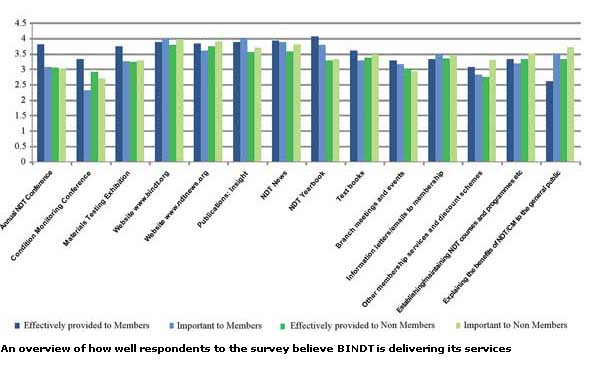Good response to BINDT survey
17/12/2010
BINDT has grown significantly over the last few years and has developed a number of areas, such as certification, education and publishing, and believes it is meeting the expectations of our industry. However, any dynamic organisation needs to consult with its customers and be aware of the environment in which it operates. To achieve this BINDT tasked the Industry Committee to gather feedback on its performance, both from members and non-members, to ensure future strategy fulfils its charitable objective: “To promote and advance the science and practice of non-destructive testing, condition monitoring, diagnostic engineering and all other materials and quality testing disciplines”. The Industry Committee believed the best way to achieve this was to carry out a survey of members and non-members, which was completed earlier this year.The survey was very well supported, with an extremely good response. Below are some key points:
There were 442 respondents: 48.3% were members, 51.7% were non-members.
Of those members, 59.9% were Member grade, 3.2% Student grade and 10.4% Graduate.
The percentage in each age group was approximately 25% in each of the 30s, 40s and 50s age bands, with 17% less than 30 years. This was surprising in some respects given the common view that we are not attracting younger people into the industry.
Looking at the roles people were employed to do, 47% were at practitioner level, 27% supervisory and 25% as management. Therefore, to continue to develop BINDT, it must meet the needs of the biggest sector, practitioners, as well as academic activities.
For NDT disciplines, the qualifications held were: MPI 77.8%, UT 76%, LP 74.8%, Radiography 52% and ET 28.5%. Relating these to industry sectors, weldments were by far the highest at 85%, with castings at 45% and aerospace at 19%.
For condition monitoring, thermography was the largest sector at 51%, followed by vibration analysis at 30%, acoustic emission at 25.6% and tribology at 18%.
The ‘percentage of people working in market sectors‘ showed that the biggest users are offshore oil and gas at 57.6%, followed by petrochemical at 48.5%, power generation at 47.8%, aerospace 27% and nuclear at 34% (note that users work across multiple sectors). Also of note is that 38% worked in service inspection, indicating NDT/CM remains a significant contracted out part of end users’ business.
From studying the information, the Industry Committee consider the response representative of the industry in the UK, covering a wide spectrum of people involved in NDT and related disciplines.
The chart below gives an overview of how well the Institute is delivering its services.

The chart shows that, for most activities, the Institute matches its activities closely to those expected and is generally delivering above expectation. The major exception to this is the last item: ‘Explaining the benefits of NDT to the general public’. In this case, both members and non-members believe this to be important, and that BINDT could do a better job.
There were more general questions asked that required a written response designed to extract respondents’ thoughts about how BINDT is performing, ideas for improvements and the perceived benefits to members.
Looking at the benefits, by far the most popular response was related to the status gained from being a member, reflecting that membership demonstrated professionalism in the industry. Linked to this was membership helping in securing work, implying that end users see it as a mark of competence. Other responses showed the role of providing information, both industry news through NDT News and technical papers in Insight, and being part of a community.
Ideas for improvement were requested, and 152 people completed this section, 41 of which would like to see BINDT focus more on the practitioners in the industry. It is felt Insight is too technical, but NDT News is hitting the right note, and the improvements to this publication are to be encouraged. 14 people would like to see more promotion of NDT, which would include provision of information to other societies and, potentially, shared exhibition space at non-NDT events.
Overall, the survey provides a very useful and detailed window into the UK NDT market. We can take encouragement that, for many, BINDT is performing a useful function and has considerable support to develop. The information gathered will be used by BINDT to develop and direct its activities in the coming years and at the Council meeting on 30 September it was agreed to establish a Working Group to analyse the results in detail, and to suggest ways to address the outcomes.
Already as a result of the survey, the Industry Committee has looked at providing a platform at non-NDT specific exhibitions, and will support further development of NDT News at Council. It is good to see support for more effort to be put on NDT outreach, and the completion of the DVD/You Tube video will aid greatly in this. There are also changes proposed to Council whereby the promotion of NDT is an assigned role to one of the Vice Presidents, bringing increased focus and co-ordination.
The Industry Committee wishes to thank everyone who participated and looks forward to updating you on actions taken.